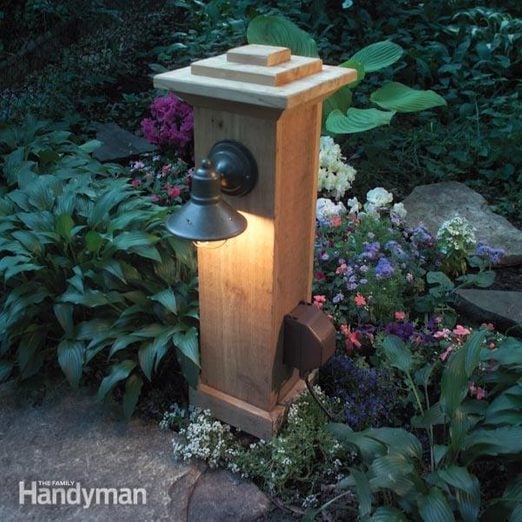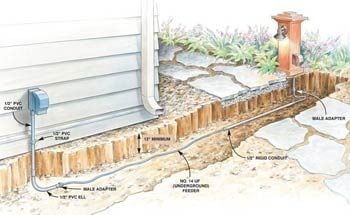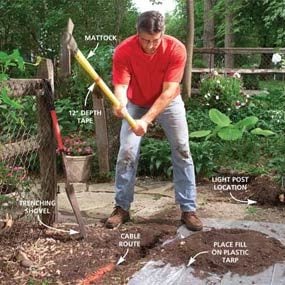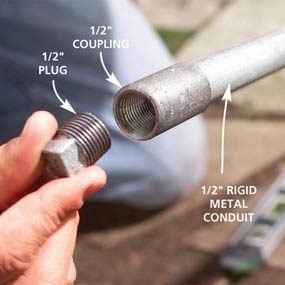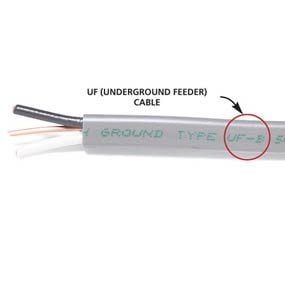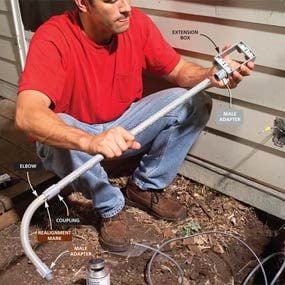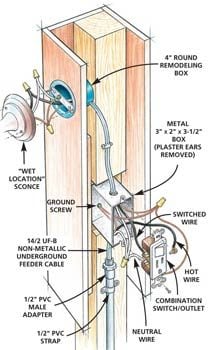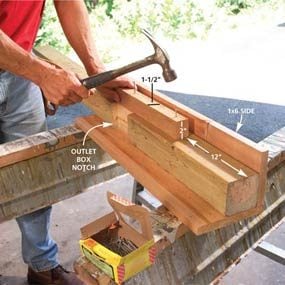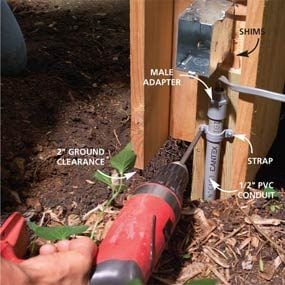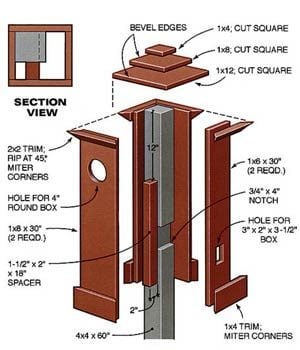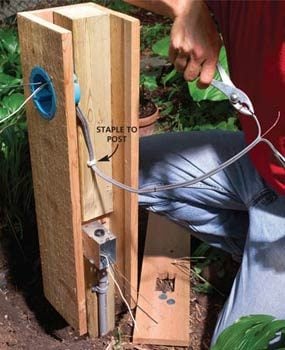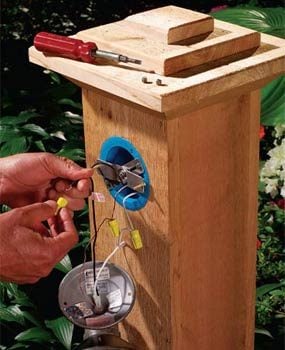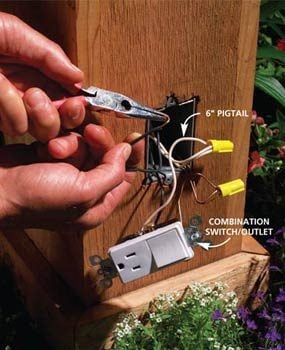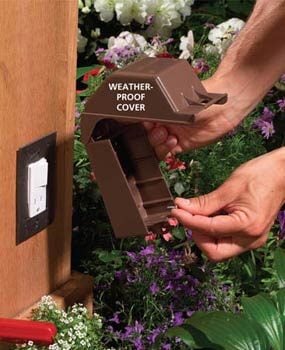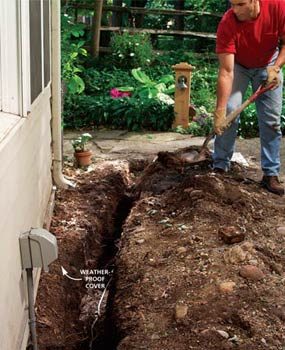How to Install Outdoor Lighting and Outlet
A full day
Intermediate
$101–250
Introduction
Run an underground electrical line into the garden to power an outdoor light. Here's the quickest and cheapest method for bringing power to a remote spot without tearing up your yard.Tools Required
- 4-in-1 screwdriver
- Adjustable wrench
- Circular saw
- Jigsaw
- Non-contact voltage tester
- Posthole digger
- Sledgehammer
- Spade
- Wire stripper/cutter
Materials Required
- Mattock
- Trenching shovel
Say you need a bright yard light way out in your yard or a remote outlet to power a pond pump or electric tools. By far the best way to get electrical power right where you need it is to run underground ‘line’ voltage (120-volt household current). Running electrical wire outside takes isa little electrical moxie and a willingness to dig a shallow trench.
In this article, we show the easiest, quickest and cheapest method to safely run electricity outdoors. Our method involves directly burying UF (underground feeder) plastic shielded cable 12 inches below ground level. We’ll also show you a no-sweat way to run the line under a walkway and how to hook up the wiring at both ends.
For this project, you should have the fundamental wiring skills it takes to make proper connections and the basic electrical and carpentry tools. While they’re not crucial, a trench shovel, a mattock and a sledgehammer will make the trench work easier and faster. Allow about a day to complete this project, assuming you collect all the parts in advance.
In our project, we run a line from an existing outdoor outlet on the house to a light and receptacle at the edge of a garden path. It incorporates a combination light switch/outlet. The outlet is always hot, and the switch controls only the light. If you don’t have an outdoor box to tap in to, consider installing an outdoor outlet on your house.
You can expand the project to include additional outlets, switches and lights. The techniques for running the wire and mounting electrical boxes are the same. However, make sure not to overload the circuit.
While we enclosed the electrical boxes inside a hollow post, you can simply mount a weatherproof box on the side of a 4×4, as long as you protect the cable by running it in conduit from the trench bottom to the box.
Project step-by-step (16)
Tap into House Wiring
- Determine where you want the electrical post positioned and then find the nearest existing outlet to supply the power.
- Note: That outlet must be GFCI protected.
Mark the Route and Dig
- Mark the cable route from the power source (house outlet) to the position of the remote outlet with spray paint.
- Call the utility companies to mark any underground lines.
- Get an electrical permit, either from your local building inspections department or a state office.
- Dig a 12-inch deep trench connecting the two points and the 2-foot deep posthole for the light.
- Pile the dirt on a strip of plastic next to the trench.
- Pro tip: Give trees a wide berth to avoid chopping through roots. Approach sidewalks or paths at right angles for easier tunneling and make sure to plan a 3-foot long straight section of trench on one side of the walkway. That’s so you’ll have room for driving the conduit beneath it.
- After the trench is finished, dig a posthole at the end of the trench about 2 feet deeper than the trench to receive the light pole post.
FYI for GFCI
To make sure the “feeder” outlet you choose is GFCI protected, look for the characteristic GFCI buttons, or if it’s a standard outlet, check it with a GFCI tester. Standard outlets still may be GFCI protected by being linked to another GFCI outlet elsewhere in the house. If yours isn’t protected, simply replace the standard outlet with a new GFCI outlet using the techniques we show in Photo 13 and Figure A. Another option is to cut in, mount and wire a new outside GFCI outlet, feeding it from an outlet mounted on an inside wall in the house. Sometimes that’s easier than digging a long trench to a more distant power source.
You also have to make sure the new outlet/light won’t overload the circuit you tie into, and that the box is big enough to handle the additional wire. To determine whether the circuit you want to use can handle the additional electrical demand, first shut off the circuit in the main panel. Then go through the house turning on lights and other electrical items. Add up the wattage of everything that stays off (the items on the circuit). Then add on the wattage of the post light plus the wattage of items continuously powered by the outlet. We recommend a maximum connected load of 1,440 watts for a 15-amp circuit and 1,920 watts for a 20-amp circuit (the amperage is stamped on the breaker or fuse). If the total wattage exceeds these amounts, find a different circuit. If you’re not sure, call in a licensed electrician to help with this part.
Run Conduit Under the Sidewalk
- Drive 1/2-inch rigid metal conduit under the walkway with a sledgehammer.
- Pro tip: Never use “thin wall” conduit, which corrodes quickly, or plastic conduit, which is too weak.
- Protect the ends with fittings (lower photo) and lay wood blocks in the trench to keep the conduit clear of the trench bottom.
Push the Wire Through
- Replace the conduit fittings with plastic bushings.
- Lay the UF cable in the bottom of the trench and push the cable through the conduit.
- Note: Wire rated for underground use carries a stamp on the jacket (lower photo).
- Cut it to length, leaving 3 feet of extra cable at the post hole and at the outlet.
Assemble the Parts
- Turn off the circuit breaker to the house outlet.
- Test it to make sure it’s dead and disconnect it.
- Cut to length and dry-fit the PVC parts, then glue up the assembly.
Bring the Cable to the Power Source
- Feed the cable through the conduit and screw the exterior extension box to the existing box.
- Fasten the conduit to the siding with a strap and file two 1/8-inch deep weep holes at the bottom of the box.
Partially Preassemble Your Light Post
- Partially preassemble the light post before it’s wired so you can stick it in the ground and have full access to the interior for stapling wires and making the hookups.
- Pro tip: But make sure that the light fixtures you choose are rated for “wet location.” You’ll find that designation on the fixture box.
- Test-fit the fixture on the post before cutting the hole for the round electrical box to make sure it clears all of the trim.
Notch the Post
- Cut a 4-inch tall x 1/2-inch deep notch in the 4×4 x 60-inch post.
- Nail two sides and a 1-1/2 x 2-inch nailer to the post as shown.
- With a jigsaw, cut the hole for the round electrical box in the second 1×8 and nail it to the post assembly.
Cut Holes for the Electrical Boxes
- Trace and cut the hole for the outlet box in the second 1×6.
- Tack the 1×6 to the sides, then slip the box through the hole and screw it to the notch.
- Shim out the box if needed, and then remove the 1×6.
Set the Post
- Set the post assembly in the hole and adjust the height
- Fill and pack soil around the post bottom.
- Assemble and glue the plastic conduit parts.
- Run the cable through it and strap it to the post.
Fasten the Light Box
- Install the light box and run a cable from it to the outlet box.
- Insert both cables and fasten them to the outlet box with cable clamps.
Add the Light Fixture
- Finish the wood trim on the post.
- Hook up the light fixture following the manufacturer’s directions.
Wire the Switch
- Connect the switch/outlet with 6-inch ‘pigtails’ for the neutral and ground.
Install the Weatherproof Cover
- Mount the gaskets and screw special weatherproof covers over the switch/outlet for this project.
Connect to the GFCI Outlet
- Connect the hot and neutral wires leading to the post to the “load” terminals on the GFCI.
- Connect the house wiring to the “line” terminals.
Finish Up
- Add a weatherproof cover to the house outlet.
- Fill the trench after the electrical inspection.
Electrical Connection Tips
- GFCI outlets have two sets of terminals, “line” and“ load.” Line is for the incoming wires from the power source, and load is for the switches, outlets and fixtures that it supplies. Don’t wire it improperly or users won’t be protected against shocks caused by damp ground or standing water.
- Cut and dry-fit all of the PVC parts. Before taking them apart for gluing, draw alignment marks on each joint. That way you’ll get them back together in the proper orientation.
- Apply “duct seal” putty to the bottom side of the top hub plugs in the extension box at the house. That will keep water from entering the box.
- The male adapters and plastic bushings on the ends of pipes are to protect the cable from the sharp pipe edges. They’re not only required but also a good idea, so don’t skip that step!
